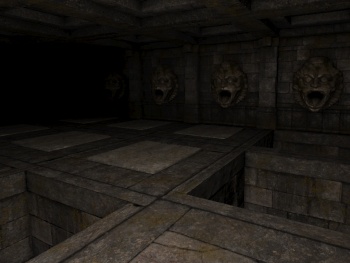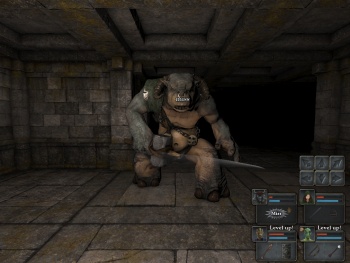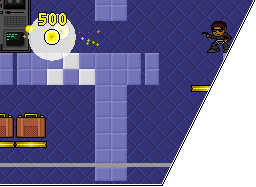I'm not sure exactly what's gone wrong with me mentally, but I've been enjoying playing through Legend of Grimrock recently. Its approach is pretty simple - you form a four-person party of fighters, mages and rogues from a selection of humans, minotaurs and insectoids, and you're sent into a grid-based 3D dungeon full of doors, buttons, switches and enemies, and your objective is to explore and reach the bottom. I always found dungeon crawl games completely impenetrable during the 90s when people were building so many three-dimensional-ish games out of the Advanced Dungeons and Dragons rules, but Etrian Odyssey must have... done something to me.
Most of my previous experience with these games was from Eye of the Beholder, a game which assumes that you know a lot about the D&D rules, seems to consist mostly of butting your head against walls to find unmarked secret passages, and which traps you underground with poisonous giant ants while taking away your ability to rest halfway through the first dungeon. (I actually replayed it quite recently, finally got myself past that bit with the use of a guide, and then got stuck about eight inches later, dying on some laser floor tiles while being stabbed and paralyzed by a great big mantis.) This update to the genre happily gets rid of a lot of the awfully irritating bits - there's still the occasional hidden switch, but for the most part, the puzzles are at least forthcoming about what elements they have. A lot of rooms look rather like Knightmare, with their opening and closing pits, and it's very satisfying to find your way over to the next challenge. The combat with the various creatures of the dungeon - including, horrifyingly, horse-sized snails from the very start - is less satisfying, mostly because the miss rate still really gets to me. In the Japanese approach to RPGs, missing is something that's quite a rare event, caused mostly by having your chance to hit ruined by status effects, and your statistics trickery is usually based around trying to reduce the damage dealt by successful attacks on your party. In the Dungeons and Dragons rules that Eye of the Beholder used, being 'missed' is very much part of the system and you have to try to tailor statistics to encourage it happening on your own characters while making sure they miss enemies as little as possible. This game doesn't complicate things as much as the AD&D games did, but you still miss enemies that are standing in front of you about half the time, and I'm unprepared to believe that anyone who knows the correct end at which to hold a sword could be that bad with one.
I'm getting oddly negative here, even though I rather enjoyed it - I feel its problems are just inherent to the genre. It had some clever ideas like the grid of runes to cast spells, even though I never found myself using any of the spells that involved clicking more than two of them, and it's full of optional secrets (the Iron Doors that taunt you on the statistics page) that encourage you to look a little deeper. I was also impressed with the ending - I thought it had one of the most oppressive conclusions that I'd seen in a game since Earthbound, with the environment suddenly becoming very dark and metallic and giving you an unusual objective, even doing some odd things to the interface after a while as it seems everything turns against you. And the awkward nature of the combat only helps the ghastly enemies seem even more frightening - this game drew more yelps out of me than any Silent Hill has, and when you hear the flapping of undead wings or the scuttle of something far too big for its own legs just beyond a wall next to you, it's difficult not to just curl up where you stand. There's one thing that I feel people should be warned about, even though it might give away a puzzle solution - keep a skull. This isn't a problem if you have the character trait that allows you to increase in attack power depending on how many skulls you carry, but if you don't... on the ninth level, you're suddenly asked for one of these items - there are five in the entire game, and by that point you've most likely picked them up, turned them over, examined them, flung them against walls or down pits or put them in boxes somewhere, and you'll have no idea where to get one. At that point I was saved by studying someone's map online and finding a skull that I hadn't previously touched, but... it's at that point that the game really does something surprisingly mean-spirited, for something that until then has done quite a good job of bringing only the good parts of those games into the modern age. Anyway, the release trailer will show you all you need to know. And so will Dungeon Master. (Additionally, the theme music is absolutely stunning, though sadly it's the only song of its kind in the game.) 2012-05-16 19:35:00 Comment on this entry |
 Track the T
Track the T


